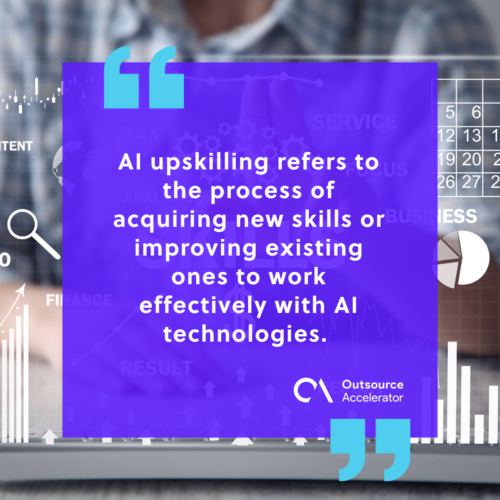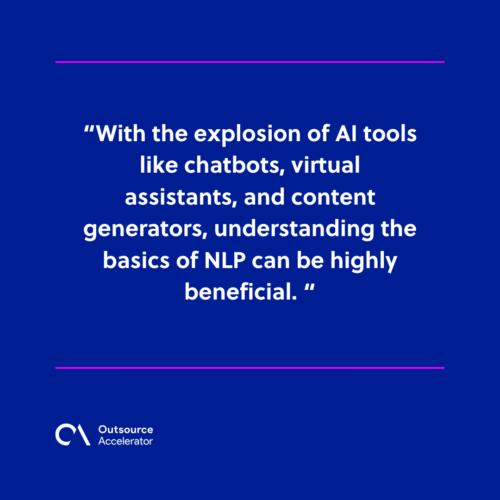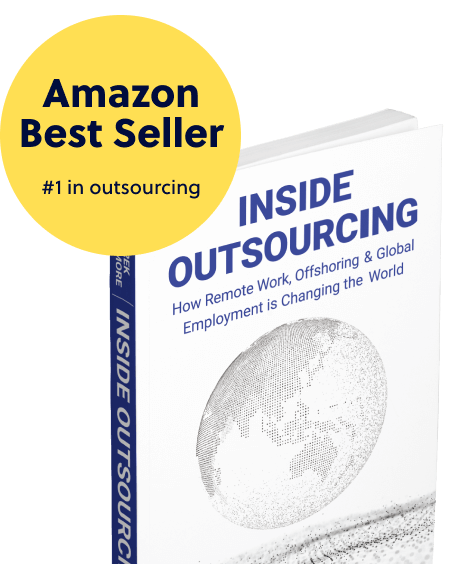AI upskilling: Preparing today’s workforce for tomorrow’s technology

The digital tide has turned, and at its crest rides artificial intelligence (AI), compelling a fundamental reassessment of our skills.
This isn’t gentle automation. AI’s growing intelligence is remaking how we strategize, how we build, how we serve, and the very architecture of industries.
In this rapidly unfolding drama, AI upskilling transcends a mere advantage. It’s the lifeline to long-term career viability and organizational resilience.
In the 536th episode of the Outsource Accelerator Podcast, Dom Procter, Founder and CEO of Outsourced Staff, touches on why his company emphasizes AI upskilling to stay ahead of the tech.
Grasping the true essence of AI upskilling and forging a strategic path is now the critical narrative for anyone intent on remaining relevant in the work of tomorrow. This article explores AI upskilling and why it matters to progress.
What is AI upskilling?
AI upskilling refers to the process of acquiring new skills or improving existing ones to work effectively with AI technologies.
It doesn’t necessarily mean becoming a data scientist or a machine learning engineer overnight. Rather, it involves gaining the knowledge needed to understand, collaborate with, or manage AI tools in the context of one’s role.
For technical professionals, it could mean learning how to build machine learning models or automate processes with AI frameworks.
For non-technical roles, AI upskilling might involve:
- Understanding how to interpret AI-generated insights
- Working with intelligent systems
- Overseeing projects that leverage AI in ethical and strategic ways
It’s about developing a working fluency with AI — enough to use it confidently and responsibly.

Why AI upskilling matters
AI is no longer just a futuristic concept; it’s woven into our daily lives, from recommendation engines on streaming services to AI-driven chatbots handling customer queries. In the workplace, AI tools are helping teams analyze large datasets, predict market trends, personalize customer experiences, and even recruit talent more efficiently.
McKinsey’s recent digital report notes that 92% of companies plan to invest in generative AI over the next 3 years. It also finds that 48% of employees rank training as the most crucial element for adoption.
Without AI upskilling, employees risk becoming obsolete in a workforce that increasingly values digital literacy and technological adaptability. Companies, too, risk falling behind if their teams lack the expertise to deploy AI effectively.
By investing in AI upskilling, individuals can future-proof their careers, and organizations can maintain a competitive edge.
Dom is transparent about this training being part of Outsourced Staff.
“We genuinely have an ethical responsibility to not put everyone out of work. [We have] upskilling… For me and for our business, we now have a training program to elevate [our staff].
Moreover, AI upskilling isn’t just about technical survival, but about opportunity. Those who embrace AI literacy often find themselves better positioned for leadership roles, innovation projects, and more impactful work.
5 Key areas of focus for AI upskilling
When approaching AI upskilling, it’s essential to focus on areas that have broad application across industries and roles.
Here are five critical areas to prioritize:
1. Machine Learning basics
Understanding the fundamentals of machine learning (ML) — a core subset of AI — is essential. Even if you don’t plan to build models yourself, knowing how algorithms learn from data, make predictions, and improve over time gives you a critical lens for evaluating AI tools and solutions.
2. Data literacy
AI runs on data, and the ability to collect, clean, interpret, and make decisions based on data is becoming a must-have skill.
Data literacy goes beyond spreadsheets; it involves understanding patterns, visualizations, statistical concepts, and how biases in data can impact AI outputs.
3. AI ethics and responsible AI
As AI becomes more powerful, ethical concerns grow louder. Learning about responsible AI practices — fairness, transparency, accountability, and bias mitigation — is vital.
Professionals must understand how to question the outputs of AI systems and ensure that technology is deployed in a way that aligns with organizational values and public good.
Dom believes that “any AI still needs to be, in my opinion, controlled by a human.
So you may have an element that is hands off, but then the AI needs to be QA-ed. The AI needs to be taught what’s right, what’s wrong.”
4. Natural Language Processing (NLP)
With the explosion of AI tools like chatbots, virtual assistants, and content generators, understanding the basics of NLP can be highly beneficial.
Even non-technical teams in marketing, HR, and customer service can leverage NLP-powered tools to automate tasks and enhance interactions.

5. Human-AI collaboration
The best companies don’t replace humans with AI, but instead augment their staff’s abilities. Learning how to work effectively alongside AI, manage hybrid human-machine workflows, and use AI tools to enhance creativity and productivity is a major part of future-proofing one’s career.
This is why Dom has implemented a hybrid solution.
“You’ve got your humans and you’ve got your technology and mix the two.”
Effective strategies for AI upskilling
Building AI-related skills doesn’t happen overnight. It requires a thoughtful, ongoing approach.
Here are five effective strategies for AI upskilling:
1. Enroll in targeted online courses and certifications
Platforms like Coursera, edX, and Udacity offer specialized AI and machine learning courses, often in partnership with top universities or tech companies.
Look for programs tailored to your career path — whether it’s technical (like Python for Machine Learning) or business-focused (like AI for Everyone by Andrew Ng).
2. Participate in company-sponsored training programs
Many forward-thinking companies are investing in in-house AI upskilling initiatives. Take advantage of any internal workshops, webinars, or mentoring opportunities.
These programs often blend technical education with real-world case studies relevant to your industry.
3. Apply AI tools to real-world projects
Theory is helpful, but nothing beats hands-on experience. Identify areas in your current role where AI could be applied.
These may be automating reporting, enhancing customer service through AI chatbots, or using AI analytics to better understand customers. Small, practical experiments can quickly build confidence and competency.
4. Join professional communities and attend AI events
Learning doesn’t have to be a solo journey. Joining AI-focused professional groups on LinkedIn, attending industry webinars, and participating in conferences helps you stay on top of trends, build a network of peers, and gain exposure to real-world applications of AI.
5. Cultivate a growth mindset toward technology
Finally, the most important strategy might be psychological: cultivating an attitude of curiosity and adaptability.
AI technology evolves rapidly, and no course or certification will keep you prepared forever. Adopting a mindset that welcomes learning, experimentation, and even occasional failure will set you apart in the AI-driven workforce.
Dom closes with this thought, emphasizing an attitude of open-mindedness.
“It’s still not being implemented as much as I think the media makes out, but it is changing rapidly. So you’ve got to be aware of it and, you know, you can’t stick your head in the sand.
You’ve got to be knowledgeable and educate yourself and use the tools that they’re giving us.”







 Independent
Independent




